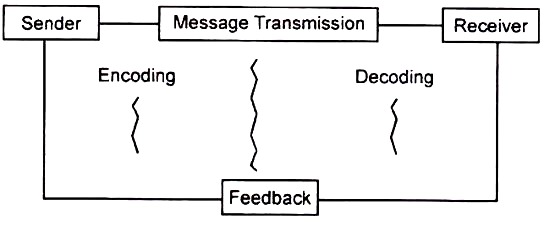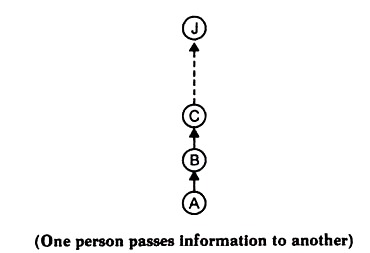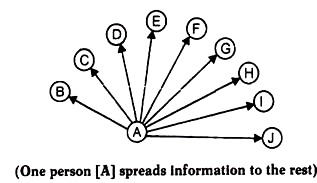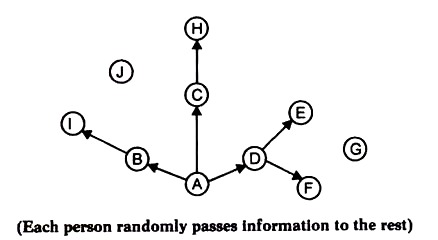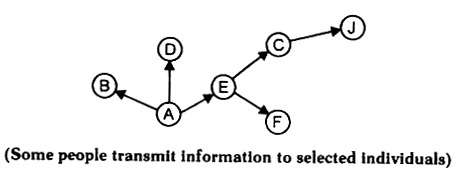After reading this article you will learn about:- 1. Meaning of Communication 2. Nature of Communication 3. Role 4. Importance 5. Process 6. Channels.
Meaning of Communication:
Communication can broadly be defined as exchange of ideas, messages and information between two or more persons, through a medium, in a manner that the sender and the receiver understand the message in the common sense, that is, they develop common understanding of the message.
The word communication is derived from the Latin word ‘communicare’, which means to share, impart, participate, exchange, transmit or to make common. It emphasises on sharing common information, ideas and messages. It is not merely issuing orders and instructions.
“Communication is the transfer of information from a sender to a receiver, with the information being understood by the receiver”. — Koontz and Weihrich
“Communication is the art of developing and attaining understanding between people. It is the process of exchanging information and feelings between two or more people and it is essential to effective management.” — Terry and Franklin
“Communication is the sum of all things one person does when he wants to create understanding in the mind of another. It is a bridge of meaning. It involves a systematic and continuous process of telling, listening and understanding.” — Allen Louis
“Communication is the process by which people attempt to share meaning via the transmission of symbolic messages.” — Stoner and Wankel
Nature of Communication:
Communication has the following features:
1. Two-way process:
Communication is a two-way process of understanding between two or more persons – sender and receiver. A person cannot communicate with himself.
2. Continuous process:
Exchange of ideas and opinion amongst people is an ongoing process in business and non-business organisations. Continuous interaction promotes understanding and exchange of information relevant for decision-making.
3. Dynamic process:
Communication between sender and receiver takes different forms and medium depending upon their moods and behaviour. It is, thus, a dynamic process that keeps changing in different situations.
4. Pervasive:
Communication is a pervasive activity. It takes place at all levels (top, middle, low) in all functional areas (production, finance, personnel, sales) of a business organisation.
5. Two people:
A minimum of two persons — sender and receiver — must be present for communication to take place. It may be between superiors, subordinates and peer group, intra or inter se.
6. Exchange:
Communication involves exchange of ideas and opinions. People interact and develop understanding for each other.
7. Means of unifying organisational activities:
Communication unifies internal organisational environment with its external environment. It also integrates the human and physical resources and converts them into organisational output.
8. Verbal and non-verbal:
Though words are active carriers of information, gestures can sometimes be more powerful than words. Facial expressions, sounds, signs and symbols are the non-verbal forms of communication.
9. Mutual understanding:
Communication is effective when sender and receiver develop mutual understanding of the subject. Messages conveyed should be understood by the receiver in the desired sense.
10. Goal-oriented:
Communication is goal-oriented. Unless the receiver and sender know the purpose they intend to achieve through communication, it has little practical utility.
11. Foundation of management:
Though communication is a directing function, it is important for other managerial functions also. Designing plans and organisation structures, motivating people to accomplish goals and controlling organisational activities; all require communication amongst managers at various levels.
12. A means, not an end:
Communication is not an end. Effective communication is a means towards achieving the end, that is, goal accomplishment. It smoothens managerial operations by facilitating planning, organising, staffing, directing and controlling functions.
13. Human activity:
Since communication makes accomplishment of organisational goals possible, it is essential that people understand and like each other. If people do not understand each others’ viewpoint, there cannot be effective communication.
14. Inter-disciplinary:
Communication is the art of how communicators use knowledge of different fields of study like anthropology, psychology and sociology. Making best use of these disciplines makes communication effective. It is, thus, an inter-disciplinary area of management.
Role of Communication:
Right from the time a child is born, communication plays an important role in his life. Speaking, listening and writing are the common forms of communication. A large part of our time is devoted to communication as we share our thoughts and feelings with individuals and groups of people. Communication helps to develop an organised society with defined roles for each individual.
In the business world, managers perform their tasks and responsibilities through communication. Communication provides the basis for effective implementation of plans, assigning jobs to people, carrying out directions and activities and facilitates control.
Management functions can be performed successfully when managers communicate face-to-face, telephonically or electronically with their superiors, peers, subordinates, customers, suppliers, competitors etc. Even when they are not talking, they are busy reading or writing reports, memos and letters which are different forms of communication. Communication has reduced geographical distances into storable and confidential forms and has facilitated a large number of people to interact with each other.
It is important that communication should be effective. Effective communication is transfer of information along with transfer of understanding. It means transfer of messages, ideas and information in a manner that the sender and receiver understand the subject in the same sense.
“It is the process of sending a message in such a way that the message received is as close in meaning as possible to the message intended.” Effective communication, thus, takes place when receiver understands the message in the same sense as the sender wants to convey.
Communication is the foundation for human interaction that develops common understanding amongst two or more persons. This promotes common objectives through coordinated efforts amongst people belonging to different functional departments.
Importance of Communication:
The desire to socialize and get formed into organised groups necessitates the need for communication. In the fast changing world, managers communicate changes in technology, structure or people to the subordinates. If the communication system is well organised, it becomes easier for subordinates to understand and act upon the message. Communication plays important role in the lives of individuals and organisations.
The following points highlight the importance of communication:
1. Basis for planning:
Planning is the basic function of management. If plans are well designed and communicated for their implementation, it leads to organisational success. Planning requires extensive environmental scanning and information about internal and external organisation elements. An effective system of communication helps in obtaining this information. Implementing the plans requires communicating them to everybody in the organisation. Communication is, thus, the basis of planning.
2. Motivation to work:
Employees are motivated to work if their needs are satisfied. Communication helps managers know needs of their employees so that they can adopt suitable motivators and inspire them to develop positive attitude towards the work environment.
3. Job satisfaction:
Exchange of information develops trust, confidence and faith amongst managers and subordinates. They understand their job positions better and, thus, perform better. People are committed to organisational objectives which promotes job satisfaction,
4. Commitment to organisational objectives:
Managers who follow an effective system of communication understand employees’ needs, adopt suitable motivators to satisfy them, appraise their performance and provide them regular feedback. The employees also work with commitment towards organisational objectives.
5. Coordination:
Communication coordinates organisational resources (human and non- human), individual goals with organisational goals and internal environment with external environment. Coordination is the key to organisational success and communication is an active contributor to coordination.
6. Adaptability to external environment:
In order to survive in the changing, dynamic environment, managers continuously interact with external parties like government, suppliers, customers, etc. This requires effective communication system in the organisation.
7. Internal functioning of an enterprise:
Managers interact with parties internal to business enterprises. They constantly obtain and provide information to them. More effective the communication system, more accurate will be the information.
8. Healthy industrial relations:
Satisfied workers contribute to healthy organisations. Communication brings managers and trade unions closer, develops mutual understanding and promotes industrial peace and harmony. This increases industrial production.
9. Helps in performing managerial roles:
According to Henry Mintzberg, managers perform three major roles – interpersonal, informational and decisional. Communication helps managers in performing these roles effectively. In interpersonal roles, managers interact with superiors, peers and subordinates; in informational roles they receive and give information to people inside and outside the organization and in decisional roles, they take important decisions and communicate them to organisational members for their effective implementation.
10. Facilitates leadership:
Effective leaders interact with followers, guide and inspire them to perform the individual and organisational goals. Effective communication process facilitates leaders to carry out the leadership functions.
11. Facilitates control:
Planning is effective if accompanied by an effective control system. Control is possible when managers assess subordinates’ performance, correct and prevent deviations and provide them regular feedback of performance. Control function largely depends upon communication system of the organisation. How effectively managers control organisational activities depends upon how effective is the communication system.
12. Training and development:
Imparting training and development facilities to employees depends upon how well their superiors communicate with them. Trainers with good communication skills are better than those who have poor communication skills.
13. Substance to organisational existence:
Obtaining information to make plans, making members aware of authority-responsibility structure, position in the organisational hierarchy, coordinating their activities is the essence of organisational survival and growth. This is possible through effective communication.
Process of Communication:
Communication process is a sequence of activities where message sent is understood by the receiver in its intended meaning. For example, execution of a purchase order or conversation through telephone shall be complete if the desired result is achieved, that is, supplier sends the desired goods and receiver of phone call acts as desired by the maker of the call.
Communication is a process that connects the sender with the receiver of the message. A process is “a systematic series of actions, operations or series of changes directed to some end.” However, in real life situations, communication process is more complex than it sounds. It consists of a series of elements which results in sharing of meaning by sender and receiver.
These elements are discussed below:
1. Sender:
Sender is the person who initiates, generates and sends the message. He represents the source of message. The communication process begins when the sender develops an idea or message he wants to transmit. He must arrange the ideas in a manner that can be understood by the receiver. A lecturer delivering a lecture in the classroom is the sender of the message or a manager addressing his team in a meeting is sender of the message.
2. Message:
Message is the idea or information that the sender wants to convey. He may convey it verbally (by writing or speaking) or non-verbally (through gestures or body language). Whatever the form, the message should be clearly formed so that desired objective is accomplished.
3. Encoding:
Once the sender is clear of what message to transmit, he decides the code through which the message shall be transmitted. The message is abstract and intangible and, therefore, has to be converted into some form (words, gestures, pictures etc.) to make it meaningful. Encoding means converting the message into symbols.
Encoding gives meaning to the message or converts ideas into codes which can be understood by the receiver. Encoding means translating the message into words (written or spoken), symbols or gestures. It may be a combination of the three. The code should be appropriate to the situation, that is, interpreted by the receiver in the manner intended.
4. Transmission:
Transmission involves selecting the medium or channel of communication. Once decided that the message has to be sent in writing, the sender may select the electronic channel and the medium of e-mail or fax. Short messages can be transmitted through telephone but lengthy messages can be sent through letters or circulars.
Choice of channel depends upon the message to be conveyed, personal biases of the sender and nature of information. Short messages are generally sent through telephone. Where drawings, charts and illustrations form part of the message, it should be sent in writing. Personal biases include sender’s preference for a particular channel.
Some senders prefer to communicate in writing, howsoever short the message may be and, therefore, prefer the written channel of transmission. Nature of information refers to immediacy and confidentiality of information. Confidential information where immediate feedback is required is generally transmitted orally.
5. Receiver:
Receiver is the person or a group of persons to whom the message is conveyed. In case of telephonic conversation, the sender can send message to one receiver but in case of group discussions, seminars and conferences, receivers can be more than one. The message must be designed, encoded and transmitted in a manner that receiver can understand it easily. Use of technical words, jargons and complicated symbols should be avoided. Depending on the channel selected, receiver may be a listener, viewer or a reader.
6. Decoding:
Decoding means giving meaningful interpretation to the message. On receiving the message, the receiver translates the symbols into meaningful information to the best of his ability. Communication is effective if receiver understands the message in the same way as intended by the sender. The receiver must, therefore, be familiar with the codes and symbols used by the sender.
7. Noise:
It represents the disturbing factor in the process of communication. It interferes with effective communication and reduces clarity of the message. The message may be interpreted differently than intended by the sender. Conversing near a machine making sounds, disturbance in telephone line, physical ailment or mental distress of sender or receiver, psychological barriers (degree of trust, fear, perception etc.) are the common forms of noise that obstruct the quality of message transmitted from sender to the receiver.
8. Feedback:
Feedback is receiver’s response to sender’s message. The receiver communicates his reaction to the sender through words, symbols or gestures. It is the reversal of communication process where receiver becomes the sender and sender becomes the receiver. Unless the receiver responds to the message, communication process is incomplete.
Feedback helps the sender to transform his message, if needed. It also allows the receiver to clear doubts on the message, ask questions to build his confidence and enables the sender to know efficiency of the message. Feedback makes the communication process complete.
In face-to-face communication, the sender can immediately receive the feedback but in written communication, it takes time for sender to receive feedback on the message. A written notice sent by manager to the employees to work seven days a week instead of six can be implemented when everybody has read and signed the notice. Subordinates will give feedback on the notice and recommend changes, if required. Managers can implement the notice only if it is accepted by the subordinates, unless it is an order.
Feedback increases efficiency and applicability of communication.
Feedback plays important role in two-way communication. In one-way communication, sender communicates with the receiver without getting any feedback but in two-way communication, receiver provides feedback to the sender. Though one-way communication takes less time and is more orderly (it avoids noise and chaos), feedback in two-way communication makes it more accurate and precise.
Feedback offers the following benefits:
1. It allows senders to improve communication with the receiver.
2. It allows receiver to clarify doubts on the message and, therefore, perform better.
3. Allowing receivers to ask questions builds confidence and they are more confident of their performance.
4. It enables the sender to know efficiency of his message; whether or not the receiver has understood the message in its right meaning. Feedback makes the communication process complete.
5. In response to receiver’s understanding and suggestions on the message, sender can adjust the subsequent messages.
However, two-way communication should be used constructively. If sender and receiver hold conflicting opinions and none is ready to agree to the other’s viewpoint, the message cannot be acted upon. Blaming each other with defensive reasoning and not acting in support of the message can reduce efficiency of the message. Two-way communication cannot be avoided and, therefore, both the parties should hold aside their egos and arrive at consensus in case there are conflicting opinions about the message.
The communication process can be represented as follows:
Channels of Communication:
Communication channel is the path through which information flows from sender to receiver.
Two main communication channels are:
I. Formal communication channel and
II. Informal communication channel.
I. Formal Communication Channel:
It is the official channel of communication controlled by managers in their official capacity. Official information and decisions follow this channel of communication. This channel is officially recognised by the organisation structure, follows the formal chain of command for passing information, suggestions, orders etc. and defines authority-responsibility relationships amongst members of the organisation.
It is a deliberately created path of communication. Information flows vertically, horizontally and diagonally along this path of communication ‘through proper channel’, that is, through various levels in the organisational hierarchy.
Vertical communication represents flow of information from one level to the other in the organsational hierarchy. It can be downward and upward. In downward vertical communication, information flows from top to middle-level managers, lower-level managers, supervisors and workers.
The information is related to goals, policies, directions, instructions etc. In upward vertical communication, information flows from lower-levels to higher levels. It relates to reports about subordinates’ work, achievements and progress, work-related problems, suggestions to improve the style of working etc.
Horizontal communication flows amongst people at the same level. It does not follow the official chain of command. When manager of marketing department discusses issues related to production and sale of goods, with the manager of production department, it is said to be horizontal communication. Diagonal communication is similar to horizontal communication that takes place amongst people of different departments at different levels rather than the same level.
Merits of formal communication:
Formal communication channel has the following merits:
1. Authentic information:
It is an officially recognised path of communication and, therefore, whatever information flows in whatever direction (vertical, horizontal or lateral), it is presumed to be authentic.
2. Large geographical area:
Large organisations have branches spread over wide geographical areas. Formal communication channels spread information over wide geographical areas.
3. Justify organisational hierarchy:
Who is to receive information from whom, where, when and to what extent is clearly specified in the formal channels.
4. Coordination:
Formal channels coordinate the work of other functional areas and facilitate smooth functioning of the organisation.
5. Control:
It helps in receiving right information at the right time and facilitates control of organisational activities.
6. Filtering of information:
Only important information which top managers must know flows to them. They do not have to, therefore, scan every information, relevant and irrelevant. This saves time which can be spent on strategic issues.
Limitations of formal communication:
Formal communication channel suffers from the following limitations:
1. Information distortion:
When information passes through a number of levels, some of the information is lost in transit and gets filled by some unintended information. There may be, thus, information distortion. In some cases, information up to eighty per cent gets lost on the way.
2. Time-consuming:
As information passes through a number of levels, it is a time-consuming channel of communication.
3. Expensive:
It is an expensive channel of communication as it requires lot of paper and administrative work.
4. Lack of personal touch:
People at the top and bottom communicate with each other through formal channels only. They do not get to talk to each other personally. Lack of personal touch restricts free flow of information in the organisation. Formal communication channel cannot be avoided. Efforts should be made to reduce its limitations and make it an effective channel of communication.
II. Informal Communication Channel:
It is an unofficial channel of communication that arises out of socio-psychological needs of people to interact with each other. It is an important and spontaneous outgrowth of formal channels of communication. It emphasises more on the person than position. It arises when people of common nationality, caste or religion interact with each other or when they share a car pool or meet each other regularly in canteens, libraries, bus stands etc.
Grapevine communication:
It is an informal communication network where information flows freely throughout the organisation. Grapevine is the most common form of informal communication. It connects people in the organisation and transmits information in every direction: vertical, horizontal and diagonal.
It cuts across formal positions and facilitates social, personal and psychological interaction amongst people. Though it travels faster than formal communication channel, it also carries gossips and rumours with it. Grapevine communication normally occurs when some change is introduced in organisational policies (change in office, automation etc.) and people are located close to each other (as individuals or groups) in order to discuss matters.
Features of grapevine communication:
Grapevine communication has the following features:
1. It connects almost everybody in the organisation.
2. It flows in every direction – vertical, horizontal and diagonal.
3. It does not follow the official chain of command.
4. It is a fast channel of communication.
5. It generally occurs at the work site, though it may occur outside the organisation also.
6. It arises out of social and personal interaction amongst people in the organisation.
7. It is based on people than task.
8. It generally occurs orally.
9. It occurs in various forms known as communication chains.
Patterns of grapevine communication—grapevine communication chains:
Grapevine communication chain represents the pattern in which information flows in different directions.
Kieth Davis identifies four types of communication chains:
1. Single-strand chain:
In this chain, information passes from one person to the other in a sequential order. A tells something to B who tells it to C, C to D and so on till the information finally reaches the person concerned, say, J.
It appears like this:
2. Gossip chain:
In this chain, one person passes information to everyone else in the organisation. He is not selective about passing the information. This information may not be related to work but is of interest to all.
It appears like this:
3. Probability chain:
In this chain, information is passed randomly by one person to others. These persons further pass information in the same random fashion. This information is not significant but is somewhat interesting.
It appears like this:
4. Cluster chain:
In this chain, one person passes information to a selected few confidentially, that is, communication is done with people whom the sender trusts. Some of them keep the information to themselves and others pass it to other selected few whom they trust. Information of interest is transmitted further and rest is retained by members. It is the most common pattern of grapevine or informal communication.
It appears like this:
Merits of grapevine communication:
Informal or grapevine communication channel has the following merits:
1. Speed:
Communication through this channel spreads fast as it does not follow a definite path. The moment someone comes to know of information that is ‘confidential’ or otherwise, it spreads like wild fire throughout the organisation. It is “just between you and me” is the basis of spreading information through grapevine.
2. Supports formal communication channel:
This channel is an important supplement to formal channel of communication. Whatever cannot be communicated through formal channel, because of time or official constraints, can be successfully transmitted through informal channels.
3. Nature of information:
Information about corporate history, moral values and traditions can be better transmitted through informal channels than formal channels.
4. Feedback:
Managers can obtain feedback from subordinates regarding the policies, directions, instructions, decisions etc. through grapevine. Feedback through informal channel is faster than the formal channel.
5. Human relations:
Since informal channels cut across official positions and hierarchical relationships, they promote healthy relations amongst people in the organisation.
6. Socio-psychological needs:
This channel satisfies social and psychological needs of people to interact with each other and share their joys and sorrows. It creates a sense of belongingness in the group and strengthens their group identity.
Limitations of grapevine communication:
Informal communication channel suffers from the following limitations:
1. Information distortion:
Since information is not based on facts, it may be misleading and distorted.
2. Lack of authenticity:
Informal communication is not authentic. Different people may-interpret the same information in different ways.
3. Fixing responsibility:
Origin of information cannot be known in this channel. It is, therefore, difficult to hold responsibility for spreading false information.
4. Incomplete information:
Information filtration and distortion are the common features of informal communication. What is said by first sender is not what is received by the last receiver. There is, thus, incomplete transmission of information.
5. Lack of evidence:
It spreads by word of mouth. It is not supported by written facts. This makes it often incredible or non-dependable. Though informal channel has limitations, managers cannot eliminate it. It is an inevitable channel of communication.
Managers should make proper use of this channel to attain the formal goals. They can make use of this channel to receive feedback about organisational plans and policies and avoid spreading gossips and rumours in the organisation.
How to make effective use of grapevine communication:
Since grapevine or informal communication channel cannot be eliminated, managers should use it effectively to attain the formal organisational goals.
The following steps can help managers in this regard:
1. Managers should personally inform employees about organisational goals, plans, policies, etc. besides communicating them through the formal channel. This will avoid spreading rumours and gossips. While communicating with subordinates, managers should maintain closeness with them.
2. Enhance group discussions and activities so that people openly discuss their formal and informal problems.
3. Managers should fix some time, in a week or month, to personally meet the employees and discuss various formal and informal problems with them.
4. Managers should win the confidence of group leaders so that group goals are not contrary to individual goals.
5. As much as possible, decision-making should be participative in nature.
6. Managers should keep asking the employees about organisational plans and policies. Regular feedback can improve the organisation’s state of affairs.
7. Managers should be good listeners. If they want to be listened to, they should also listen to others.
Distinction between Formal and Informal Communication Channels:
The following table highlights the points of difference between formal and informal communication channels:
